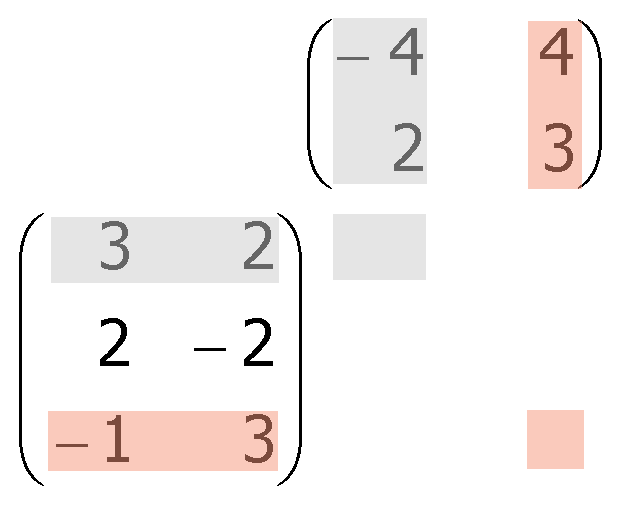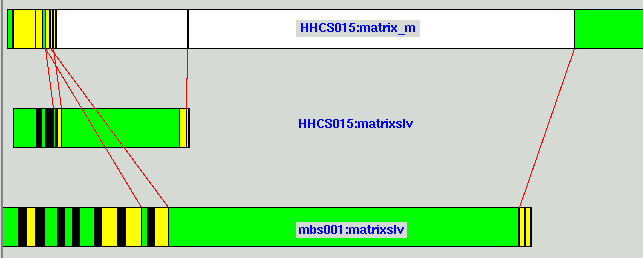Als Beispiel für die Programmierung eines Clusters mit PVM ist die Multiplikation von Matrizen sehr anschaulich. Zu erst kurz die Definition, wie Matrizen multipliziert werden.
Definition: Es sei A eine (m x k)-Matrix und B eine (k x n)-Matrix. Als Produkt A•B der beiden Matrizen ergibt sich die (m x n)-Matrix C:
![]()
Beispiel:

Für die Programmierung müssen drei Fragen beantwortet werden:
Aus den eben gestellten Fragen lässt sich ein Konzept für das "Master / Slave" Modell entwickeln:
Der Master
Der Slave
#include <stdio.h>
#include "pvm3.h"
#define MAXHOSTS 10
#define DIMENSION 100
int main(int argc, char **argv)
{
/* TID, number of hosts, number */
/* of different data types in VM */
int mytid, nproc, narch;
int info;
/* array of all TIDs */
/* number of working hosts */
int tids[MAXHOSTS], nworkers;
int num, i, j;
int numrows, extra, rownum=0, extra_num;
float A[DIMENSION][DIMENSION], B[DIMENSION][DIMENSION];
/* result matrix*/
float C[DIMENSION][DIMENSION];
FILE *outfile;
/* array for information */
/* about the hosts in VM */
struct pvmhostinfo *hosts[MAXHOSTS];
num = 0;
/* enroll in PVM */
mytid = pvm_mytid();
/* get the conf of the VM */
/* proto: */
/* int info = pvm_config( int *nhost, */
/* int *narch, */
/* struct pvmhostinfo **hostp ) */
info = pvm_config(&nproc, &narch, hosts);
/* set the number of workers */
/* if more than one host, the */
/* master will not work */
nworkers = nproc > 1 ? nproc -1 : 1;
/* spawn the slaves */
/* proto: */
/* int numt = pvm_spawn( char *task, */
/* char **argv, */
/* int flag, */
/* char *where, */
/* int ntask, */
/* int *tids ) */
pvm_spawn("matrixslv", (char**)0, PvmTaskDefault, "", nworkers, tids);
/* fill the matrixes */
num = 0;
for (i=0; i < DIMENSION; i++)
for (j=0; j < DIMENSION; j++) {
A[i][j] = num++;
B[i][j] = num++;
}
/******************************************/
/* Sending the Data */
/******************************************/
numrows = DIMENSION / (nworkers);
extra = DIMENSION % (nworkers);
extra_num = numrows+1;
/* clear default send buffer */
/* and specify decoding to default */
pvm_initsend(PvmDataDefault);
for (i=0; i < DIMENSION; i++)
/* pack one row of the B matrix */
pvm_pkfloat(B[i], DIMENSION, 1);
/* send the buffer to all workers */
/* tids = array of workers' TIDs */
pvm_mcast(tids, nworkers, 1); /* msgTag 1 */
for (i=0; i < nworkers; i++) {
pvm_initsend(PvmDataDefault);
if (extra-- > 0) { /* some extra rows are present */
/* pack number of rows to deliver */
/* this worker gets one row more */
pvm_pkint(&extra_num, 1, 1);
/* pack the number of the current row */
pvm_pkint(&rownum, 1, 1);
/* pack the current row in buffer */
pvm_pkfloat(A[rownum++], DIMENSION, 1);
}
else { /* there are no extra rows */
/* means: DIMENSION mod nworkers == 0 */
/* pack number of rows to deliver */
pvm_pkint(&numrows, 1, 1);
/* pack number of current row */
pvm_pkint(&rownum, 1, 1);
}
/* pack the rows in buffer */
/* and send to current worker */
for (j=0; j < numrows; j++)
pvm_pkfloat(A[rownum++], DIMENSION, 1);
pvm_send(tids[i], 2); /* msgTag 2 */
}
/******************************************/
/* Receiving the Results */
/******************************************/
for (i=0; i < nworkers; i++) {
/* wait and receive any msg with Tag 3 */
pvm_recv(-1, 3);
/* unpack number of current row */
pvm_upkint(&rownum, 1, 1);
/* unpack number of rows received */
pvm_upkint(&numrows, 1, 1);
/* put the received rows in result-matrix */
for (j=0; j < numrows; j++)
pvm_upkfloat((C[rownum++]), DIMENSION, 1);
}
/******************************************/
/* Write the results to file */
/******************************************/
outfile = fopen("mmult.out", "w");
for (i = 0; i < DIMENSION; i++)
for (j=0; j < DIMENSION; j++)
fprintf(outfile, "C[%d][%d]: %f\n", i, j, C[i][j]);
fclose(outfile);
pvm_exit();
}
In einem Cluster mit 2 Hosts, die beide rechnen, sieht eine grafische Darstellung des Ablaufs folgendermaßen aus:

grün = rechnend, gelb = Overhead, weiß = wartend, rot = Nachrichten
Schwarze Abschnitte entsprechen einer sehr schmalen Aneinanderreihung von gelben und grünen Abschnitten.